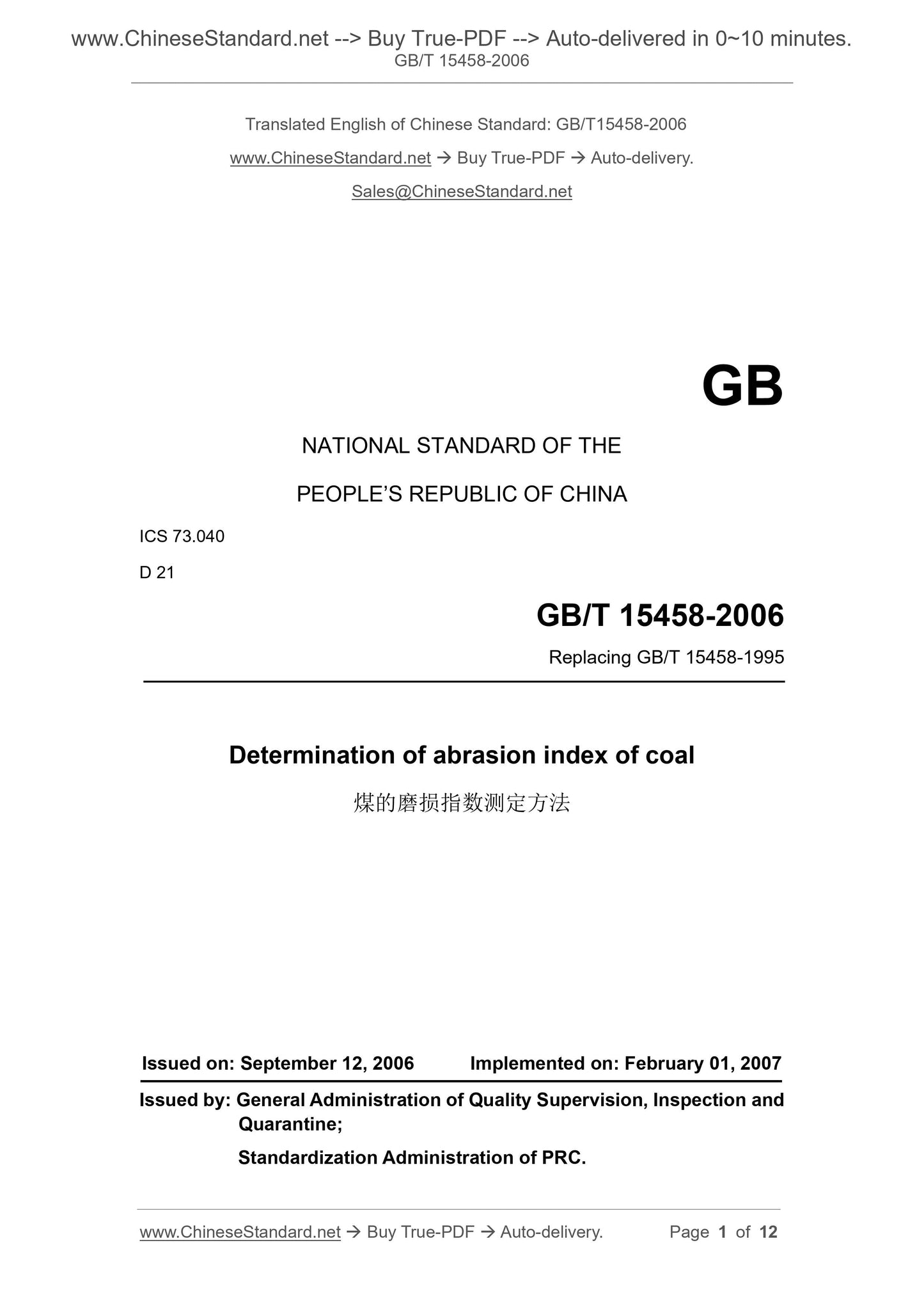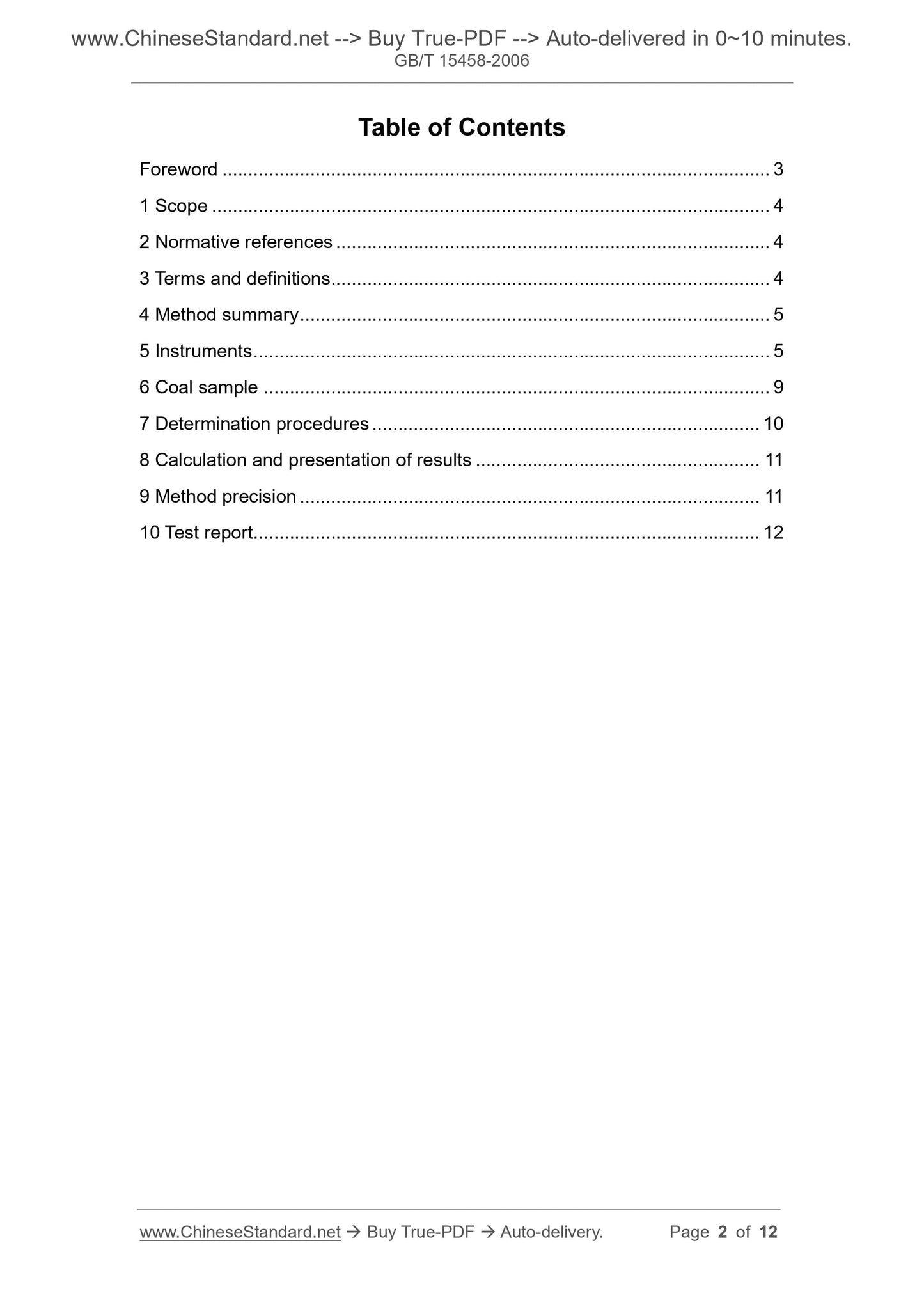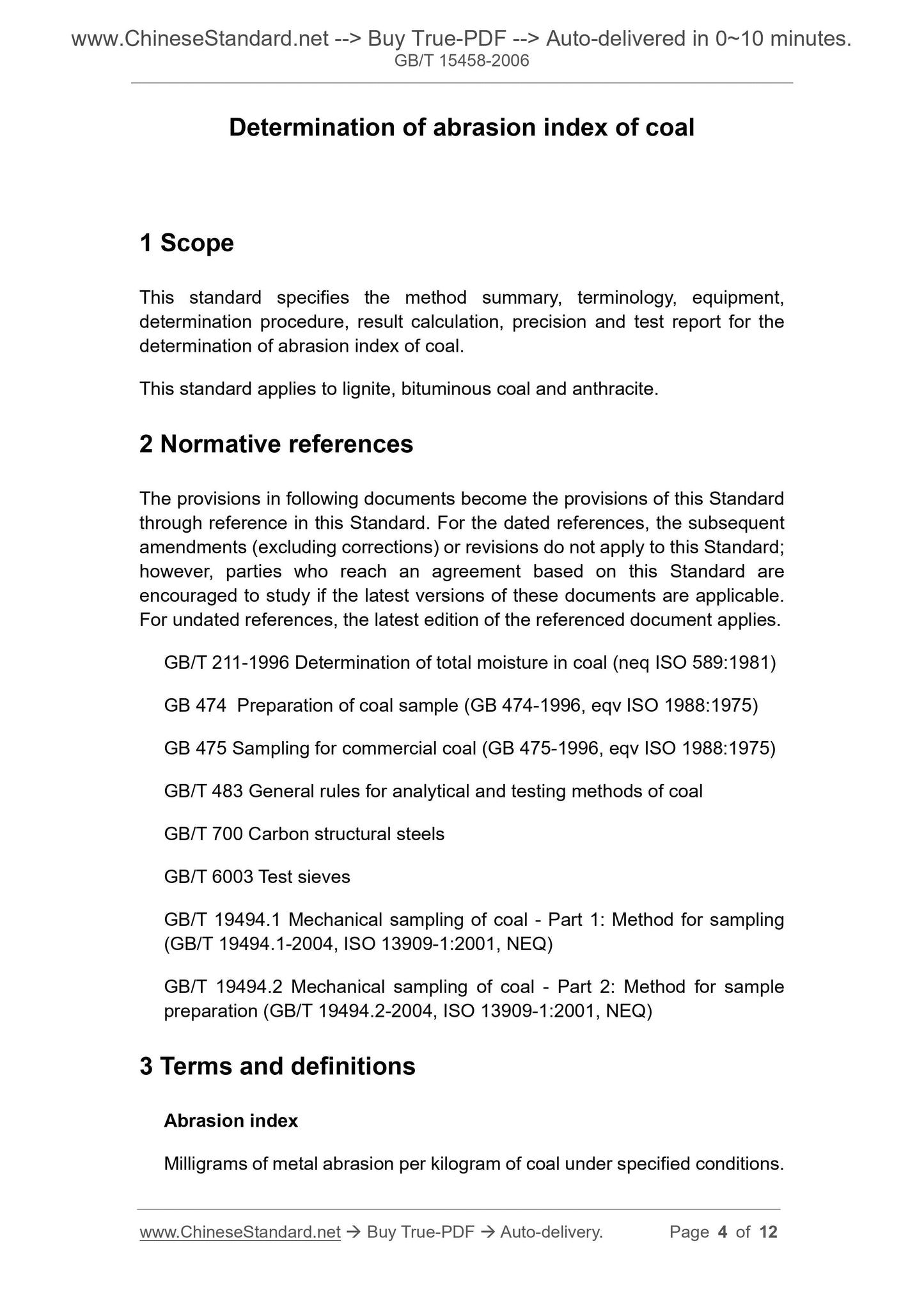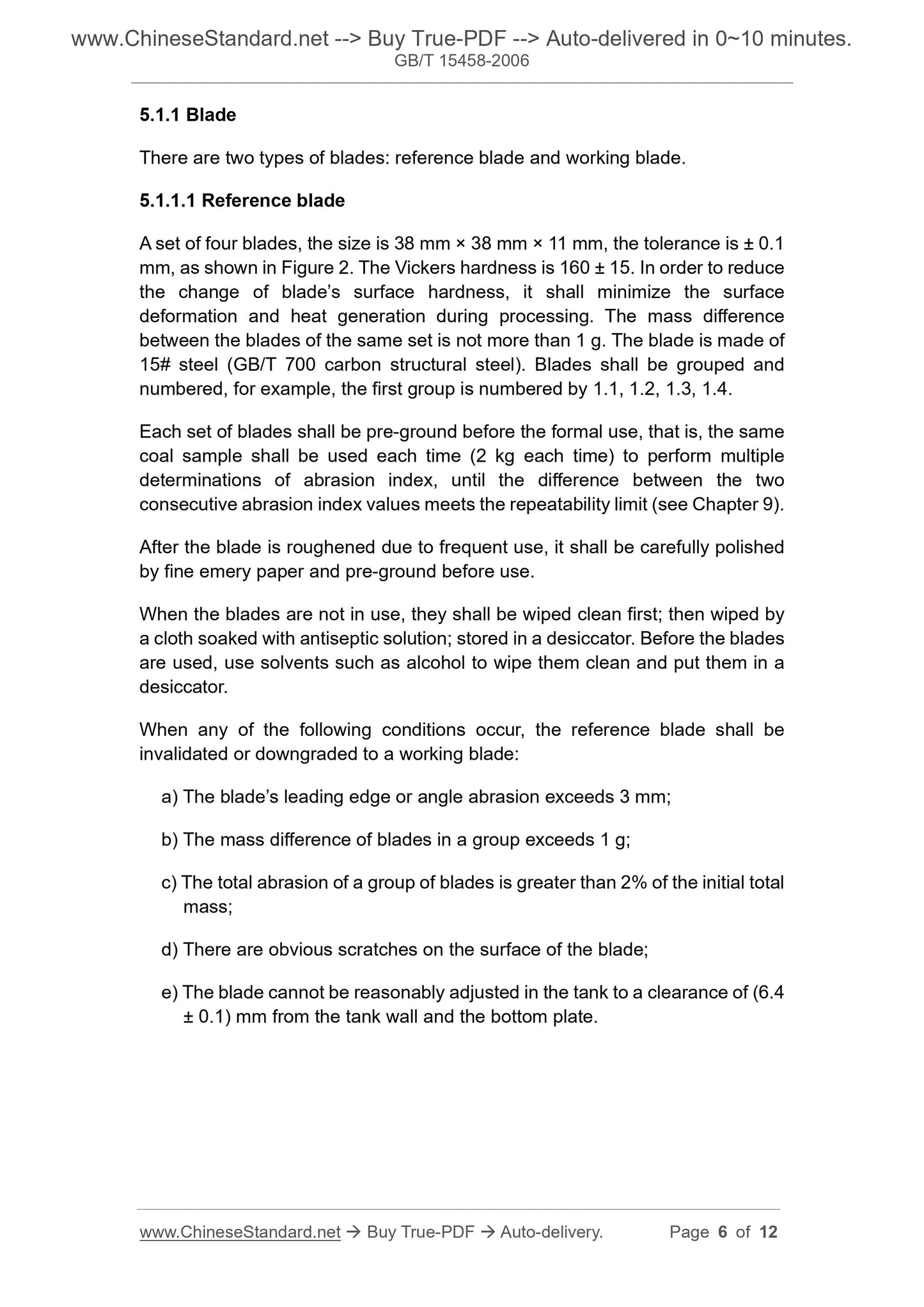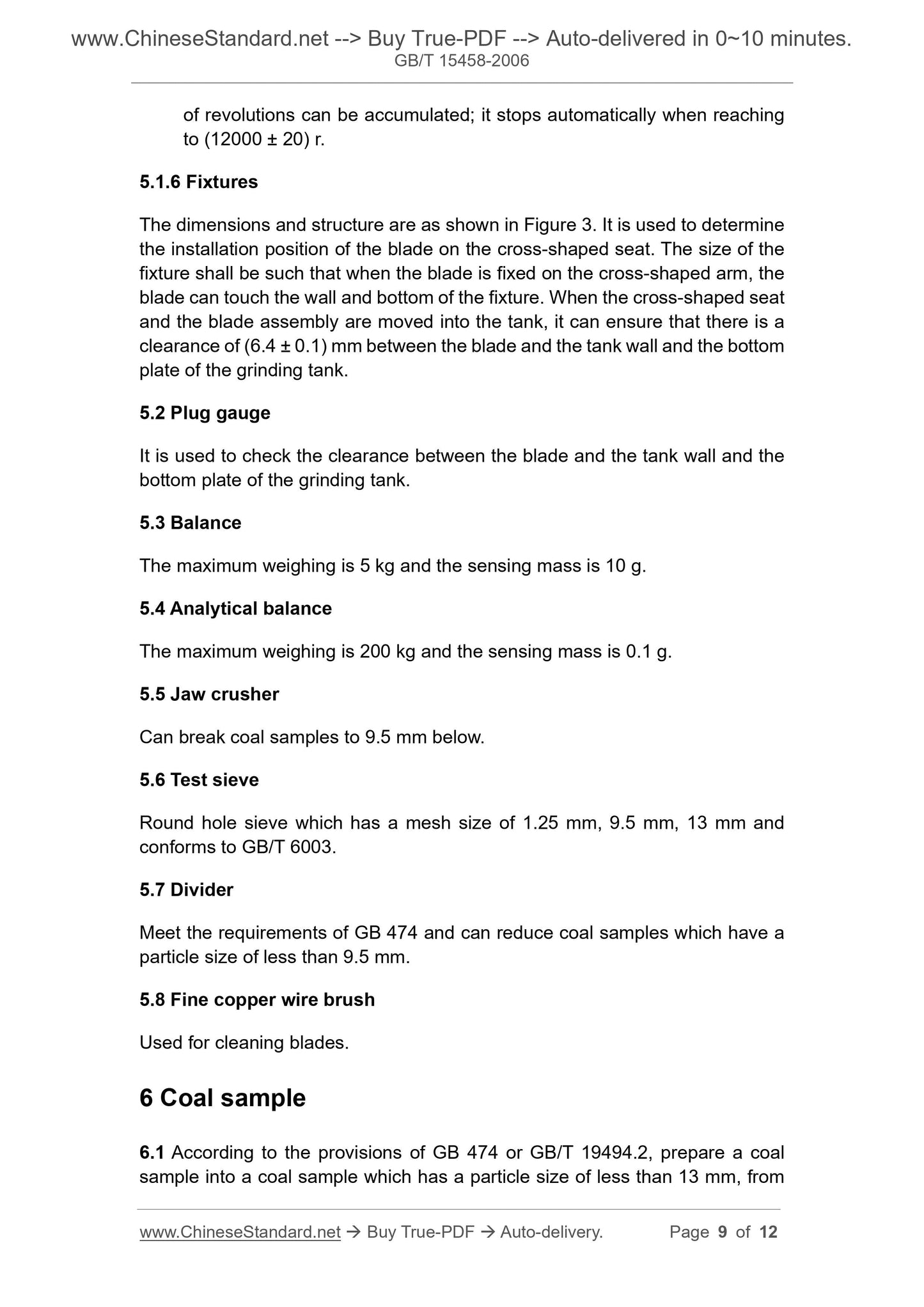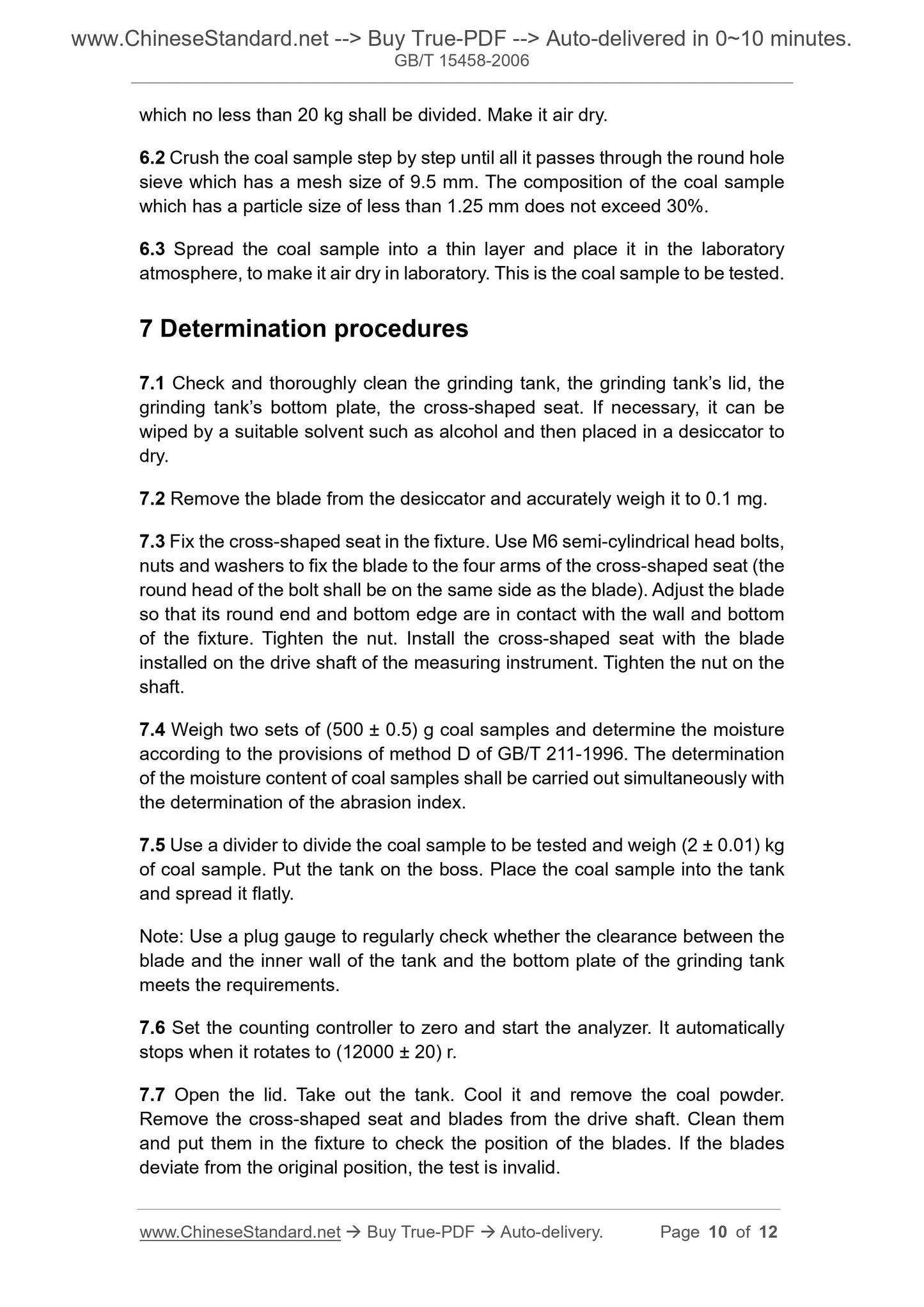1
/
of
6
PayPal, credit cards. Download editable-PDF and invoice in 1 second!
GB/T 15458-2006 English PDF (GBT15458-2006)
GB/T 15458-2006 English PDF (GBT15458-2006)
Regular price
$140.00 USD
Regular price
Sale price
$140.00 USD
Unit price
/
per
Shipping calculated at checkout.
Couldn't load pickup availability
Delivery: 3 seconds. Download true-PDF + Invoice.
Get QUOTATION in 1-minute: Click GB/T 15458-2006
Historical versions: GB/T 15458-2006
Preview True-PDF (Reload/Scroll if blank)
GB/T 15458-2006: Determination of abrasion index of coal
GB/T 15458-2006
NATIONAL STANDARD OF THE
PEOPLE’S REPUBLIC OF CHINA
ICS 73.040
D 21
Replacing GB/T 15458-1995
Determination of abrasion index of coal
ISSUED ON: SEPTEMBER 12, 2006
IMPLEMENTED ON: FEBRUARY 01, 2007
Issued by: General Administration of Quality Supervision, Inspection and
Quarantine;
Standardization Administration of PRC.
Table of Contents
Foreword ... 3
1 Scope ... 4
2 Normative references ... 4
3 Terms and definitions ... 4
4 Method summary ... 5
5 Instruments ... 5
6 Coal sample ... 9
7 Determination procedures ... 10
8 Calculation and presentation of results ... 11
9 Method precision ... 11
10 Test report ... 12
Determination of abrasion index of coal
1 Scope
This standard specifies the method summary, terminology, equipment,
determination procedure, result calculation, precision and test report for the
determination of abrasion index of coal.
This standard applies to lignite, bituminous coal and anthracite.
2 Normative references
The provisions in following documents become the provisions of this Standard
through reference in this Standard. For the dated references, the subsequent
amendments (excluding corrections) or revisions do not apply to this Standard;
however, parties who reach an agreement based on this Standard are
encouraged to study if the latest versions of these documents are applicable.
For undated references, the latest edition of the referenced document applies.
GB/T 211-1996 Determination of total moisture in coal (neq ISO 589:1981)
GB 474 Preparation of coal sample (GB 474-1996, eqv ISO 1988:1975)
GB 475 Sampling for commercial coal (GB 475-1996, eqv ISO 1988:1975)
GB/T 483 General rules for analytical and testing methods of coal
GB/T 700 Carbon structural steels
GB/T 6003 Test sieves
GB/T 19494.1 Mechanical sampling of coal - Part 1: Method for sampling
(GB/T 19494.1-2004, ISO 13909-1:2001, NEQ)
GB/T 19494.2 Mechanical sampling of coal - Part 2: Method for sample
preparation (GB/T 19494.2-2004, ISO 13909-1:2001, NEQ)
3 Terms and definitions
Abrasion index
Milligrams of metal abrasion per kilogram of coal under specified conditions.
5.1.1 Blade
There are two types of blades: reference blade and working blade.
5.1.1.1 Reference blade
A set of four blades, the size is 38 mm × 38 mm × 11 mm, the tolerance is ± 0.1
mm, as shown in Figure 2. The Vickers hardness is 160 ± 15. In order to reduce
the change of blade’s surface hardness, it shall minimize the surface
deformation and heat generation during processing. The mass difference
between the blades of the same set is not more than 1 g. The blade is made of
15# steel (GB/T 700 carbon structural steel). Blades shall be grouped and
numbered, for example, the first group is numbered by 1.1, 1.2, 1.3, 1.4.
Each set of blades shall be pre-ground before the formal use, that is, the same
coal sample shall be used each time (2 kg each time) to perform multiple
determinations of abrasion index, until the difference between the two
consecutive abrasion index values meets the repeatability limit (see Chapter 9).
After the blade is roughened due to frequent use, it shall be carefully polished
by fine emery paper and pre-ground before use.
When the blades are not in use, they shall be wiped clean first; then wiped by
a cloth soaked with antiseptic solution; stored in a desiccator. Before the blades
are used, use solvents such as alcohol to wipe them clean and put them in a
desiccator.
When any of the following conditions occur, the reference blade shall be
invalidated or downgraded to a working blade:
a) The blade’s leading edge or angle abrasion exceeds 3 mm;
b) The mass difference of blades in a group exceeds 1 g;
c) The total abrasion of a group of blades is greater than 2% of the initial total
mass;
d) There are obvious scratches on the surface of the blade;
e) The blade cannot be reasonably adjusted in the tank to a clearance of (6.4
± 0.1) mm from the tank wall and the bottom plate.
of revolutions can be accumulated; it stops automatically when reaching
to (12000 ± 20) r.
5.1.6 Fixtures
The dimensions and structure are as shown in Figure 3. It is used to determine
the installation position of the blade on the cross-shaped seat. The size of the
fixture shall be such that when the blade is fixed on the cross-shaped arm, the
blade can touch the wall and bottom of the fixture. When the cross-shaped seat
and the blade assembly are moved into the tank, it can ensure that there is a
clearance of (6.4 ± 0.1) mm between the blade and the tank wall and the bottom
plate of the grinding tank.
5.2 Plug gauge
It is used to check the clearance between the blade and the tank wall and the
bottom plate of the grinding tank.
5.3 Balance
The maximum weighing is 5 kg and the sensing mass is 10 g.
5.4 Analytical balance
The maximum weighing is 200 kg and the sensing mass is 0.1 g.
5.5 Jaw crusher
Can break coal samples to 9.5 mm below.
5.6 Test sieve
Round hole sieve which has a mesh size of 1.25 mm, 9.5 mm, 13 mm and
conforms to GB/T 6003.
5.7 Divider
Meet the requirements of GB 474 and can reduce coal samples which have a
particle size of less than 9.5 mm.
5.8 Fine copper wire brush
Used for cleaning blades.
6 Coal sample
6.1 According to the provisions of GB 474 or GB/T 19494.2, prepare a coal
sample into a coal sample which has a particle size of less than 13 mm, from
which no less than 20 kg shall be divided. Make it air dry.
6.2 Crush the coal sample step by step until all it passes through the round hole
sieve which has a mesh size of 9.5 mm. The composition of the coal sample
which has a particle size of less than 1.25 mm does not exceed 30%.
6.3 Spread the coal sample into a thin layer and place it in the laboratory
atmosphere, to make it air dry in laboratory. This is the coal sample to be tested.
7 Determination procedures
7.1 Check and thoroughly clean the grinding tank, the grinding tank’s lid, the
grinding tank’s bottom plate, the cross-shaped seat. If necessary, it can be
wiped by a suitable solvent such as alcohol and then placed in a desiccator to
dry.
7.2 Remove the blade from the desiccator and accurately weigh it to 0.1 mg.
7.3 Fix the cross-shaped seat in the fixture. Use M6 semi-cylindrical head bolts,
nuts and washers to fix the blade to the four arms of the cross-shaped seat (the
round head of the bolt shall be on the same side as the blade). Adjust the blade
so that its round end and bottom edge are in contact with the wall and bottom
of the fixture. Tighten the nut. Install the cross-shaped seat with the blade
installed on the drive shaft of the measuring instrument. Tighten the nut on the
shaft.
7.4 Weigh two sets of (500 ± 0.5) g coal samples and determine the moisture
according to the provisions of method D of GB/T 211-1996. The determination
of the moisture content of coal samples shall be carried out simultaneously with
the determination of the abrasion index.
7.5 Use a divider to divide the coal sample to be tested and weigh (2 ± 0.01) kg
of coal sample. Put the tank on the boss. Place the coal sample into the tank
and spread it flatly.
Note: Use a plug gauge to regularly check whether the clearance between the
blade and the inner wall of the tank and the bottom plate of the grinding tank
meets the requirements.
7.6 Set the counting controller to zero and start the analyzer. ...
Get QUOTATION in 1-minute: Click GB/T 15458-2006
Historical versions: GB/T 15458-2006
Preview True-PDF (Reload/Scroll if blank)
GB/T 15458-2006: Determination of abrasion index of coal
GB/T 15458-2006
NATIONAL STANDARD OF THE
PEOPLE’S REPUBLIC OF CHINA
ICS 73.040
D 21
Replacing GB/T 15458-1995
Determination of abrasion index of coal
ISSUED ON: SEPTEMBER 12, 2006
IMPLEMENTED ON: FEBRUARY 01, 2007
Issued by: General Administration of Quality Supervision, Inspection and
Quarantine;
Standardization Administration of PRC.
Table of Contents
Foreword ... 3
1 Scope ... 4
2 Normative references ... 4
3 Terms and definitions ... 4
4 Method summary ... 5
5 Instruments ... 5
6 Coal sample ... 9
7 Determination procedures ... 10
8 Calculation and presentation of results ... 11
9 Method precision ... 11
10 Test report ... 12
Determination of abrasion index of coal
1 Scope
This standard specifies the method summary, terminology, equipment,
determination procedure, result calculation, precision and test report for the
determination of abrasion index of coal.
This standard applies to lignite, bituminous coal and anthracite.
2 Normative references
The provisions in following documents become the provisions of this Standard
through reference in this Standard. For the dated references, the subsequent
amendments (excluding corrections) or revisions do not apply to this Standard;
however, parties who reach an agreement based on this Standard are
encouraged to study if the latest versions of these documents are applicable.
For undated references, the latest edition of the referenced document applies.
GB/T 211-1996 Determination of total moisture in coal (neq ISO 589:1981)
GB 474 Preparation of coal sample (GB 474-1996, eqv ISO 1988:1975)
GB 475 Sampling for commercial coal (GB 475-1996, eqv ISO 1988:1975)
GB/T 483 General rules for analytical and testing methods of coal
GB/T 700 Carbon structural steels
GB/T 6003 Test sieves
GB/T 19494.1 Mechanical sampling of coal - Part 1: Method for sampling
(GB/T 19494.1-2004, ISO 13909-1:2001, NEQ)
GB/T 19494.2 Mechanical sampling of coal - Part 2: Method for sample
preparation (GB/T 19494.2-2004, ISO 13909-1:2001, NEQ)
3 Terms and definitions
Abrasion index
Milligrams of metal abrasion per kilogram of coal under specified conditions.
5.1.1 Blade
There are two types of blades: reference blade and working blade.
5.1.1.1 Reference blade
A set of four blades, the size is 38 mm × 38 mm × 11 mm, the tolerance is ± 0.1
mm, as shown in Figure 2. The Vickers hardness is 160 ± 15. In order to reduce
the change of blade’s surface hardness, it shall minimize the surface
deformation and heat generation during processing. The mass difference
between the blades of the same set is not more than 1 g. The blade is made of
15# steel (GB/T 700 carbon structural steel). Blades shall be grouped and
numbered, for example, the first group is numbered by 1.1, 1.2, 1.3, 1.4.
Each set of blades shall be pre-ground before the formal use, that is, the same
coal sample shall be used each time (2 kg each time) to perform multiple
determinations of abrasion index, until the difference between the two
consecutive abrasion index values meets the repeatability limit (see Chapter 9).
After the blade is roughened due to frequent use, it shall be carefully polished
by fine emery paper and pre-ground before use.
When the blades are not in use, they shall be wiped clean first; then wiped by
a cloth soaked with antiseptic solution; stored in a desiccator. Before the blades
are used, use solvents such as alcohol to wipe them clean and put them in a
desiccator.
When any of the following conditions occur, the reference blade shall be
invalidated or downgraded to a working blade:
a) The blade’s leading edge or angle abrasion exceeds 3 mm;
b) The mass difference of blades in a group exceeds 1 g;
c) The total abrasion of a group of blades is greater than 2% of the initial total
mass;
d) There are obvious scratches on the surface of the blade;
e) The blade cannot be reasonably adjusted in the tank to a clearance of (6.4
± 0.1) mm from the tank wall and the bottom plate.
of revolutions can be accumulated; it stops automatically when reaching
to (12000 ± 20) r.
5.1.6 Fixtures
The dimensions and structure are as shown in Figure 3. It is used to determine
the installation position of the blade on the cross-shaped seat. The size of the
fixture shall be such that when the blade is fixed on the cross-shaped arm, the
blade can touch the wall and bottom of the fixture. When the cross-shaped seat
and the blade assembly are moved into the tank, it can ensure that there is a
clearance of (6.4 ± 0.1) mm between the blade and the tank wall and the bottom
plate of the grinding tank.
5.2 Plug gauge
It is used to check the clearance between the blade and the tank wall and the
bottom plate of the grinding tank.
5.3 Balance
The maximum weighing is 5 kg and the sensing mass is 10 g.
5.4 Analytical balance
The maximum weighing is 200 kg and the sensing mass is 0.1 g.
5.5 Jaw crusher
Can break coal samples to 9.5 mm below.
5.6 Test sieve
Round hole sieve which has a mesh size of 1.25 mm, 9.5 mm, 13 mm and
conforms to GB/T 6003.
5.7 Divider
Meet the requirements of GB 474 and can reduce coal samples which have a
particle size of less than 9.5 mm.
5.8 Fine copper wire brush
Used for cleaning blades.
6 Coal sample
6.1 According to the provisions of GB 474 or GB/T 19494.2, prepare a coal
sample into a coal sample which has a particle size of less than 13 mm, from
which no less than 20 kg shall be divided. Make it air dry.
6.2 Crush the coal sample step by step until all it passes through the round hole
sieve which has a mesh size of 9.5 mm. The composition of the coal sample
which has a particle size of less than 1.25 mm does not exceed 30%.
6.3 Spread the coal sample into a thin layer and place it in the laboratory
atmosphere, to make it air dry in laboratory. This is the coal sample to be tested.
7 Determination procedures
7.1 Check and thoroughly clean the grinding tank, the grinding tank’s lid, the
grinding tank’s bottom plate, the cross-shaped seat. If necessary, it can be
wiped by a suitable solvent such as alcohol and then placed in a desiccator to
dry.
7.2 Remove the blade from the desiccator and accurately weigh it to 0.1 mg.
7.3 Fix the cross-shaped seat in the fixture. Use M6 semi-cylindrical head bolts,
nuts and washers to fix the blade to the four arms of the cross-shaped seat (the
round head of the bolt shall be on the same side as the blade). Adjust the blade
so that its round end and bottom edge are in contact with the wall and bottom
of the fixture. Tighten the nut. Install the cross-shaped seat with the blade
installed on the drive shaft of the measuring instrument. Tighten the nut on the
shaft.
7.4 Weigh two sets of (500 ± 0.5) g coal samples and determine the moisture
according to the provisions of method D of GB/T 211-1996. The determination
of the moisture content of coal samples shall be carried out simultaneously with
the determination of the abrasion index.
7.5 Use a divider to divide the coal sample to be tested and weigh (2 ± 0.01) kg
of coal sample. Put the tank on the boss. Place the coal sample into the tank
and spread it flatly.
Note: Use a plug gauge to regularly check whether the clearance between the
blade and the inner wall of the tank and the bottom plate of the grinding tank
meets the requirements.
7.6 Set the counting controller to zero and start the analyzer. ...
Share
